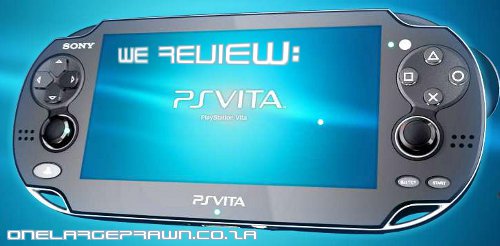It’s always big fanfares and a parade complete with seventy-six trombones whenever a new major console hits the market, and the new PS Vita, the successor to the PSP, was no different. The PS Vita, announced way back in July 2009, finally released to western shores on February 22, and we took it through its paces to see what it’s all about.
I know that as a responsible reviewer, I’m supposed to present the facts to you in the least biased way possible, and then present my opinion at the end, allowing you to either agree or disagree with the argument I’ve put forth, but I’m going to break that rule right now by saying hot damn, this is one impressive little machine! With front touch screen, rear touch pad, dual analog sticks, six-axis control, and dual cameras, the PS Vita is everything that the PSP should have been three times over. Obviously, the console is not without its flaws, so let’s see where it excels, and where it falls flat.
To start with, the Vita’s OLED capacitive touch-sensitive display is utterly beautiful. The colors are bright, the resolution is crisp, and the touch sensitivity is about what you’d expect from any modern touchscreen device. At five inches, the device isn’t tiny by a long shot, but in this case, I think Sony has reached that critical sweet spot between a device that’s too big and a screen that’s too small.
Much is being made of the comparison between the PS Vita and Nintendo’s own little darling, the 3DS (heck, I did it myself when I knew far less about either console), and my personal feeling about this now that I know more is that you can’t really compare them properly. Yes, they’re both recent handheld consoles, but they’re so far apart in terms of features, power, design, audience, game library, that about the only similarity between them is that they’re both recent handhelds. To run an analogy, yes, you could compare an apple with a durian because they’re both fruit, but they’re so different otherwise that it’s impossible to make a decent comparison. Any comparison you see between the two would be a purely subjective opinion, so your mileage may vary. Drastically. Anyway, back to the PS Vita!
The sheer number of ways of interacting with the console make it more than a match for the new brats on the gaming block, i.e., tablets and smartphones. I tried playing games on a tablet, and I have a smartphone that I regularly don’t play games on (in fact, I usually don’t play games on my smartphone on an almost daily basis!), and I despise the fact that these devices don’t have buttons. My fingers need tactile feedback to play effectively. It’s agreed that the better games for touchscreen have gotten around the problems inherent to gaming on a touch interface, but it’s way more than just troublesome to play a decent game on these devices. Racing game for example, usually leave off the reverse control. Or gear changing controls. And let’s not get into the lack of an analog stick or D-pad. The PS Vita gets around this by having buttons, analog sticks, and a touch screen. I fully expect to see ports of iOS and Android games on the PS Vita.
For the PS Vita, Sony decided to abandon the Cross Media Bar (XMB) interface used on the PSP (and which is currently in use on the PS3) and has created a new touch-based interface called LiveArea. The LiveArea home screens contain friendly, round icons for each app or game (as opposed to the standard square icons we see everywhere else—it’s a love/hate thing). The home screens are arranged vertically, allowing you ten icons per screen. Games and apps are launched on a succession of horizontal screens, so for example if you have Twitter, music, the PlayStation Store, a download queue, and a game all in motion, you can scroll left and right across the screen to go from app to app, until you arrive at the home screen on the far left. Furthermore, it’s easy to get from an app to the LiveArea: simply press the PS button, and the app you’re in minimizes to its title screen, allowing you to switch apps or fire up something else.
While we’re discussing LiveArea, let me talk about the apps that come bundled with the PS Vita out of the box. Not only do you get immediate access to a music player, a video player, camera app, the PlayStation Store, trophies, group messaging, and a web browser, you also get access to Google Maps, Twitter, Flickr, Facebook, and Foursquare (these last four via a free download from the store). You also get Near, an app that shows you other PS Vita owners in a several kilometre radius of you and what they’re playing, and Welcome Park, a set of games that introduce you to the various features of the PS Vita. Furthermore, via more Store downloads, you also get three free augmented reality (AR) games: Fireworks, Cliff Diver, and Table Football. So that’s a lot of free content either out the box or via a few downloads! Furthermore, if you’re the owner of a 3G PS Vita, you can also get T@g, an AR game that allows you to graffiti the world, and the graffiti is marked with its GPS coordinates. This also allows others to view the graffiti and overwrite or enhance it at will.
It feels a lot to me as if the PS Vita is trying to compensate for many of the weaknesses in the PS3, such as the inclusion of custom soundtracks and party chat. There are so many features built in that I’m still in the process of discovering them. One of the cooler things that I discovered quite by accident, for example, is that on each game or app’s title screen, you can scroll down the screen for a message board showing you what your PS Vita-owning friends are doing with that app. One feature I’d love to see in future system software versions is a notification on the home screen to let you know that a new message is available, since these messages don’t appear elsewhere.
The PS Vita, one must admit, has a very strong launch lineup, with over 20 main titles, not including the list of almost 300 backward-compatible PSP games and over 50 compatible PlayStation Minis games, so games are not going to be a problem, especially if, like myself, you were not previously a PSP owner. That being said, you’ll probably benefit the most from the PS Vita if you are also a PS3 owner, since the two consoles play very nice with each other. In addition to Remote Play (a feature that allows you to watch videos, play music, and play selected games stored on your PS3 using the PS Vita, including any PSOne games, where the rear touch pad becomes the proxy for the L2, R2, L3, and R3 buttons), some games, such as Motorstorm RC and Hustle Kings, also support a feature called Cross Play. This allows you to take a game that is available on both the PS Vita and the PS3, and play against an oppponent on the other console. Instant multiplayer! Just add PS Vita! In the cases of the abovementioned two games, if you buy the PS Vita version, you get the PS3 version for free.
Another plus for the PS Vita is just how family friendly it is. Parents handing the PS Vita over to their offspring can configure parental controls to finely adjust just what content the kids can view, what services the kids can fire up, and how much information kids can share. On the other hand, it would probably be a very good idea to pick up a screen protector, since the PS Vita isn’t made with Gorilla Glass, and therefore prone to scratches from little fingers.
Inevitably, any console has its down sides, and the PS Vita is no different. Its biggest downfall is its price, which many find extremely offputting. This is made a bit harder to swallow when you take into account the fact that on top of the already somewhat steep price you also need to purchase a proprietary memory card to play most games. This, coupled with the fact that there is no Monster Hunter or similar game for it probably accounts for its bad sales in Japan over the past 2 months. Time will tell how the little console will do in coming month, although initial sales in the UK and US look promising. That being said, it’s still cheaper than an iPad, iPhone, or comparably powered Android device, so take all that into account when talking about it. Plus it has buttons and dual analog sticks, which I’ll take any day of the week over a pure touch interface.
Another con is the battery life of the console. At around 5 hours for gaming to 9 hour for music alone (with the screen off), you’re going to have to charge it every day if you play a lot. And quite possibly twice a day if you play more than just a lot. Also, despite its bigger size than your average smartphone, it can still give hand cramps to adult hands after a few hours of play. Furthermore, the PS Vita doesn’t charge if it’s turned on and plugged into a USB port (although it does charge while on when plugged into the AC power), meaning that you can’t play and try charging it by USB. I’m not sure what design decision went into that, but I hope a future system update fixes this issue.
Further complaint, albeit incredibly minor, lies with the camera resolution, which sits at a piddly VGA (640×480). On the other hand, just about every other device that you own already has a multimegapixel resolution. The primary purpose of the PS Vita’s camera is more to serve to recognize the AR cards and recognize movement (much in the same way that the Move camera, although not a brilliant resolution, does the job). So as long as you understand why the camera is not 853 quintillion megapixels, it’s justifiable.

Otherwise, I really hope that Sony opens its app market to developers, allowing for as varied a store as the iOS and Android marketplaces, at similar, competitive price points. I know it’s meant for serious gaming, but this will really make the PS Vita an attractive device, as the AAA titles for it currently are still far more wildly priced than people like. For example, I’d love to see Muffin Knight for PS Vita! There’s a game that deserves buttons!
To conclude this review, I’d like to say that if you aren’t hurting for the cash, get this console. It’s beautiful and tons of fun to play. Personally, I’ve been unable to put it down for much longer than the requisite two hours it takes to charge. The touch screen in combination with the touch pad is genius, and I can’t think of how to decently play a game such as Uncharted without buttons or analog sticks. On the other hand, if you ARE hurting for the cash, it wouldn’t hurt to wait a bit for the inevitable price drop. But if an elderly relative happens to pop their clogs (sorry, was that a little insensitive of me?), and happens to leave a generous sum of money to you, then do yourself a favour and pick up Sony’s new console. You won’t be sorry.
Final score: 8 touch-sensitive, button-festooned, beautifully screened prawns out of 10
Detailed information:
Manufacturer: Sony
Distributor: Ster Kinekor
Release date: 22 Feburary 2012
RRP: R2,699 (WiFi only), R3,499 (3G and WiFi), memory cards start at R199 for 4Gb
Website: http://za.playstation.com/psvita/









